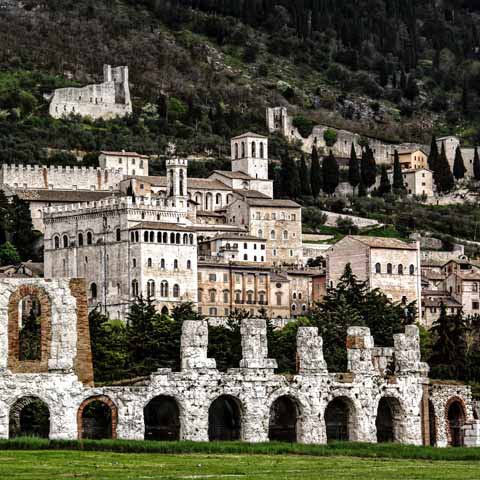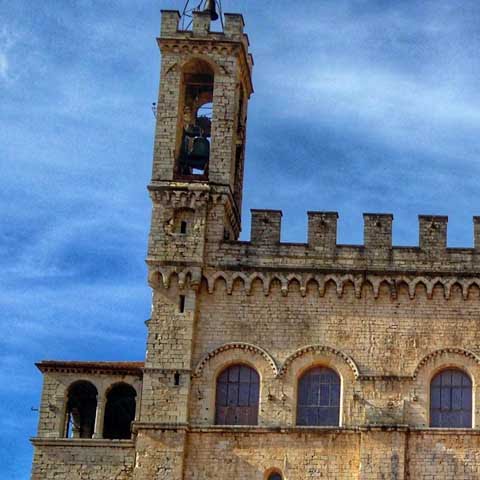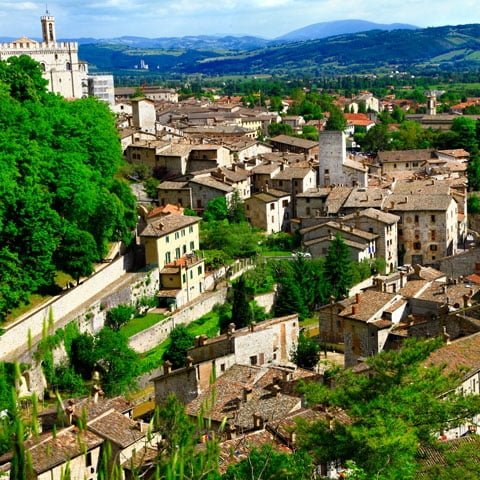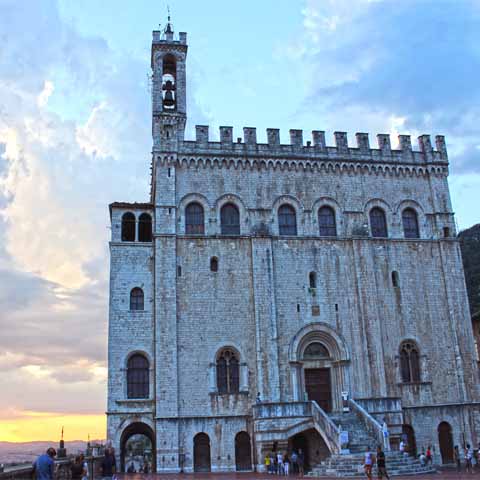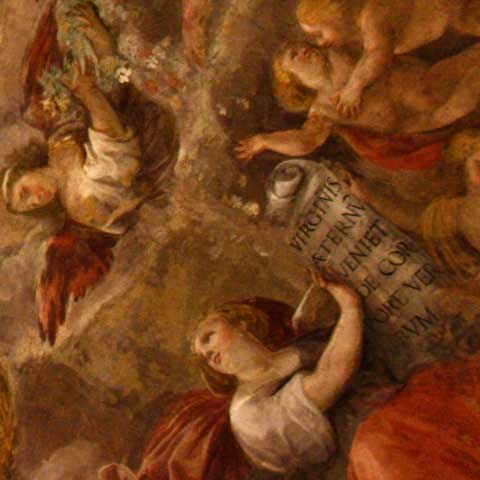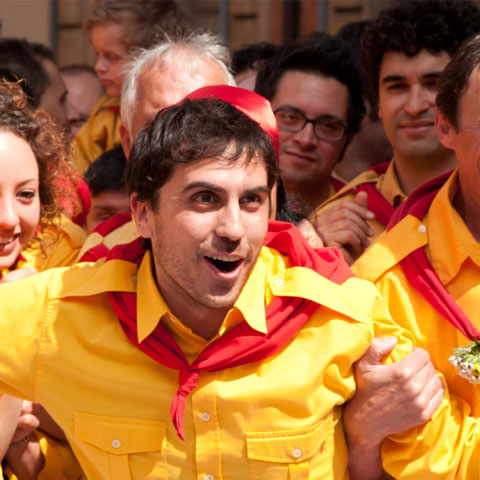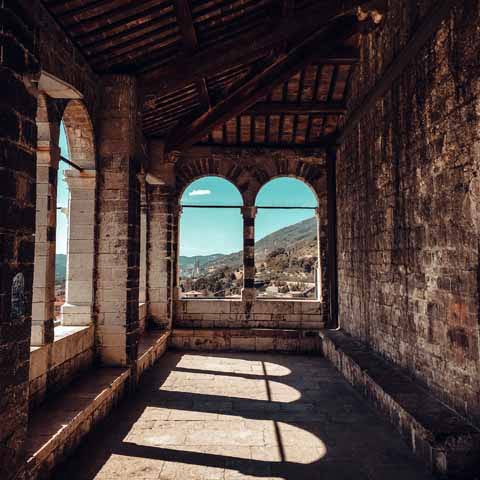Visiting Gubbio is like traveling back in time because the city is still very much rooted in a medieval place. While in Gubbio, travelers can take in the history of the town by exploring local festivities, sightseeing, museums, and more.
FESTIVALS & EVENTS
Gubbio’s culture is highly valued in the hearts of its citizens. People celebrate the city’s traditional medieval history through a variety of events and festivals.
One of the oldest and largest religious events in Umbria, the Corsa dei Ceri is a nearly 1,000-year-old event that takes place annually in May, the day before the Feast of Saint Ubaldo. The event includes mass, food, and a footrace which serves as the main event. During the race, large wooden pillars called ceri are carried through the streets of the city. The pillars are topped with statues of Saint Ubaldo, Saint George, and Saint Anthony the Great and are carried by teams wearing coordinating colors up to the Basilica of Saint Ubaldo.
Other events include the Palio della Balestra – a crossbow contest complete with a procession and music – and the Good Friday Passion – a religious event held at the Church of Santa Croce della Foce just outside the city.
During Christmastime, Gubbio is transformed into a winter wonderland, complete with colored lights that are strung all alongside the slope of the mountain to create one of the world’s largest Christmas trees with approximately 800 lights and 5 miles of cables.
OUTDOOR ACTIVITIES
The best way to enjoy the sunshine in Gubbio is to take a walk along the Via dei Consoli. There, travelers can gaze upon the medieval architecture of the town. The road leads to some of the city’s best sites, including the thirteenth century Palazzo del Bargello and the Fountain of the Fools. This fountain is a sixteenth-century sculptural piece. It is said that when you visit, you must run three times around the fountain to become one of the “madmen of Gubbio.”
A near copy of the Ducal Palace in Urbino, the Ducale Palace in Gubbio features an elegant courtyard where travelers can enjoy time outdoors. The rooms also give great countryside views.
One of the most unique outdoor activities in Gubbio for travelers to experience is taking a ride on the open air funivia, or cable car, to the top of Mount Ingino. This cable car is unlike anything else, as travelers stand one or two at a time in hanging metal baskets that look something like birdcages and ride to the top of the mountain. Not for the faint of heart, the ride is a truly unique and interesting way to take in the views of the hillside.
INDOOR ACTIVITIES
Visit the Gubbio Duomo for a look at beautiful architectural details. The cathedral was built in the thirteenth century and features a vaulted ceiling, arches, and an opulent chapel.
The Basilica of Sant’Ubaldo is a beautiful structure that is home to the remains of Saint Ubaldo, the patron saint of Gubbio. His body from the twelfth century is displayed in a glass coffin above the basilica’s ornate altar. It also features a small museum inside dedicated to the Corsa dei Ceri festival and is the home of the festival’s famous ceri, or pillars, which are transported to the Palazzo dei Consoli every May. The basilica can be reached by taking the city’s funivia, or cable car.
For fans of art and pottery, visit the Museo della Maiolica a Lustro – a museum dedicated to the a lustro style of ceramics, a style which originated during the eleventh century in Muslim Spain. On the second floor of the museum, travelers can see ceramics from all throughout history, including prehistoric, medieval, and Renaissance times.
SHOPPING
When visiting Gubbio, a visit to a ceramics shop is a must. The city is known as one of the best in Italy for high-quality ceramics. From Zaffera style to Raphaelesque to Neo-Renaissance, the designs on Gubbio ceramic pieces are varied and uniquely opulent. Travelers can purchase ceramics at specialty shops along the Via dei Consoli.
Weekly markets are also held in the city, offering a variety of unique handicrafts, leather goods, food products, and more.
FAMILIES AND KIDS
Outside of Gubbio, families with kids can visit the Bottaccione Gorge where a layer of sedimentary rock can be spotted. The area is also home to a medieval aqueduct. Another interesting stop is the nineteenth century Rangiaschi Park. The park takes on the appearance of an English garden and features medieval ruins as well as a variety of trees and plants of different species.
UNIQUE EXPERIENCES
The heart of Gubbio is Piazza Grande. This giant piazza is mainly dominated by Palazzo dei Consoli, a fourteenth-century medieval palace. The palazzo was built by master architect Matteo Gattaponi and is a symbol of Gubbio and houses the city’s Civic Museum, which is famous for its exhibit of the Tavole Eugubine. The Tavole Eugubine, or the Eugubian Tablers, are seven bronze tablets that are some of the most important documents of the Osco-Umbrian languages. The tablets are written in ancient language with Etruscan and Latin characters and are said to be translations of prayers, rituals, sacrifices, and more. The museum is also home to other artifacts such as unique coins, art, archeological pieces, and ceramics.
One of the most unique architectural features that travelers will notice while strolling the streets of Gubbio are the porte dei morti or the “doors of the dead.” Unique to Central Italy, the doors of death are very small and narrow doorways in the facades of medieval townhomes. Once open, these doorways are now shut completely with bricks. Legend says these doorways were used to slide coffins out of houses and have since been bricked up due to superstitions about death. The reality is they were likely used as a defensive measure during medieval times; however, the doors still maintain an ominous feel. Travelers will find the majority of these doors on buildings along the Via dei Consoli.
The Roman theater of Gubbio is not only a locale used for summertime concerts but also a unique archaeological destination. The remains of this first-century Roman theater is home to a small archeological museum that features ancient artifacts of Gubbio, including well-preserved mosaics of the Domus of Scylla.
Travel to the charming city of Gubbio in Central Italy to discover its many treasures. From the medieval architecture to the verdant scenery of the Umbria region, travelers of all interests will enjoy their time in Gubbio.
Travel Guides
The Umbria Region of Italy
The Cities of Umbria, Italy
